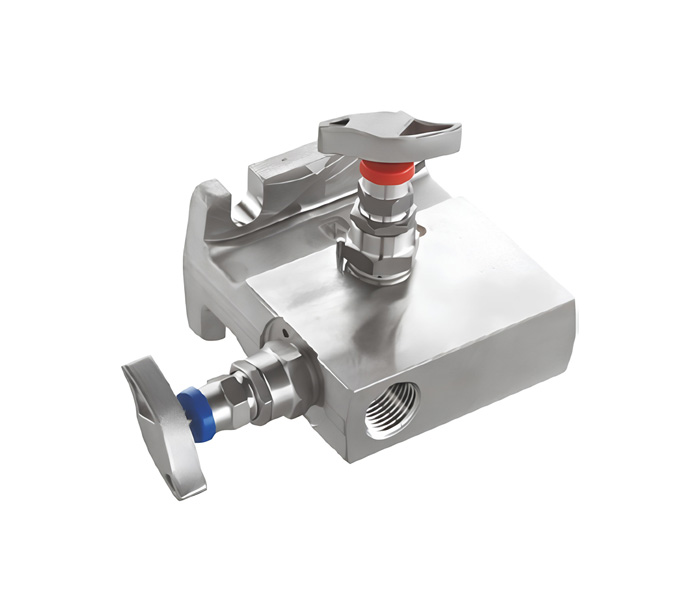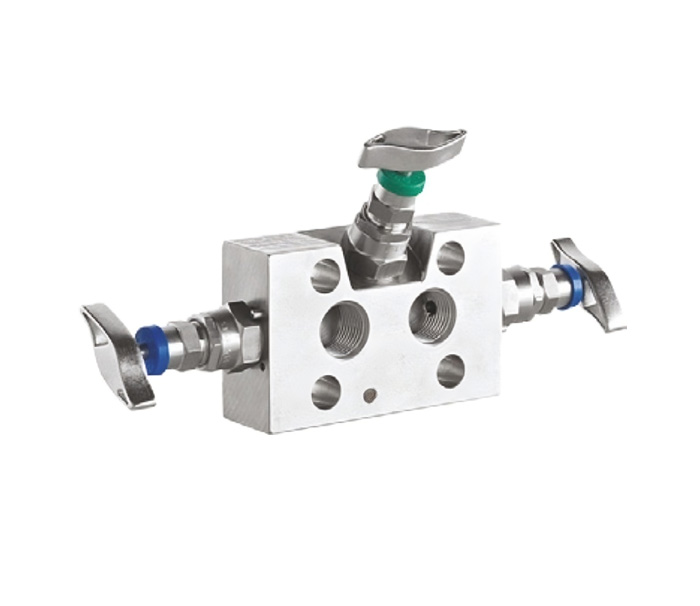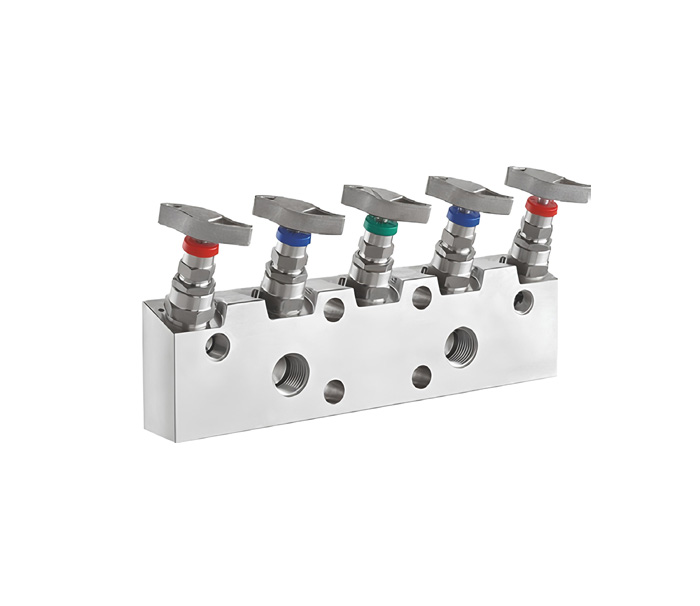
What is Manifold Valve?
Manifold valves are essential components in industrial fluid control systems, widely used in sectors such as oil & gas, petrochemicals, and process engineering. These compact units integrate multiple valves into a single block or assembly, allowing for more streamlined and efficient regulation, isolation, and distribution of fluids or gases.
A manifold valve typically connects two or more valves within a hydraulic or instrumentation system. By combining various valve types, such as needle, bleed, ball, and vent valves, into one body, manifold valves help reduce the need for multiple individual connections, minimizing potential leak points and saving valuable space.
Each valve within the manifold has a dedicated inlet or outlet port that connects to a pipe or line, while sharing a common valve chamber. This integrated design not only simplifies installation but also cuts down on maintenance time and cost.
Manifold valves are particularly valued for their ability to handle high-pressure applications while maintaining precise control. Their compact design, combined with functional versatility, makes them a reliable choice for optimizing system performance and ensuring safety in complex fluid systems.
Types of Manifold Valves manufactured by Arrotop
Manifold valves come in various configurations, each designed to meet specific operational needs in fluid and pressure control systems. These valves simplify complex piping setups, enhance safety, and improve accuracy during instrumentation processes. Below are some of the most commonly used types of manifold valves.
A 2-valve manifold is a compact solution used in fluid control, hydraulic systems, and instrumentation. It includes a block valve to isolate the instrument and a bleed valve to release pressure. Ideal for pressure transmitters and gauges, it ensures safe, reliable, and cost-effective pressure measurement and isolation.
The 3-valve manifold is used with differential pressure transmitters. It includes two block valves and one equalizing valve for balancing pressure. Ideal for remote mounting in fluid control and instrumentation systems, offering safe and accurate pressure measurement.
The 5-valve manifold features two block valves, one equalizing valve, and two bleed valves. Designed for direct mounting on pressure transmitters, it allows isolation, equalization, and venting. Ideal for high-precision measurement in hydraulic and instrumentation applications.
T-Type manifold valves feature a straight-through flow design, ideal for compact installations and panel mounting. Commonly available in 2, 3, or 5-valve configurations, they are used in fluid control, pressure instruments, and hydraulic systems for reliable isolation, equalization, and venting functions.
Product Data
Arrotop is a trusted manufacturer & supplier of high-quality manifold valves, offering a comprehensive range designed for precise and reliable flow measurement and control across various industrial applications. Built to meet international standards, Arrotop manifold valves deliver long-term performance, durability, and system integrity.
A valve manifold is a key component in hydraulic and instrumentation systems, typically comprising one or more block or isolation valves. It plays a vital role in pressure and differential pressure transducer setups. The primary function of a manifold valve is to isolate process media from pressure instrumentation, ensuring safe maintenance, calibration, or replacement without requiring a system shutdown.
Arrotop’s manifold valve solutions are available in multiple configurations and commonly feature ball, needle, bleed, and vent valves. When configured as a block and bleed system, these valves effectively prevent upstream fluid from reaching downstream components, maintaining safe and controlled fluid separation within the system.
Material : Manufactured from forged Stainless Steel – ASTM A 479, ASTM A182 F304, ASTM A182 F316, ASTM A182 F304, ASTM A182 F304L, Carbon Steel – ASTM A 105, Monel, Inconel, Hastelloy, Titanium, and other materials available upon request. NACE-compliant materials are also available.
Features :
- An anti-rotational thrust brush is employed to ensure pressure-tight sealing, maintain consistent packing compression, and minimize the creation of cold flow channels.
- A bonnet/body washer with on-site bonnet retrofitting, ensuring a 100% re-sealing guarantee.
- A T-bar is incorporated for ease of operation.
- Dual cap
- A lock nut for gland adjustment.
- Adjustment of the gland packing to compensate for wear in the gland.
- An anti-blowout spindle, featuring high-quality micro mirror stem finishing, is employed to ensure positive gland sealing.
- The gland packing is designed with minimal air adjustment to achieve optimal sealing.
- The spindle tip provides a bubble-tight shutoff, ensuring a leakage-free performance and downstream functional safety for the user.
Applications of Manifold Valves :
- Process Control Industries: Manifold Valves are extensively used in industries such as chemical processing, pharmaceuticals, food and beverage, and water treatment. They play a vital role in controlling the flow of liquids and gases to ensure precise and efficient processing.
- Oil and Gas Production: In the oil and gas industry, Manifold Valves are employed in wellhead control systems, providing a centralized point for managing fluid flow, pressure, and temperature. They are crucial for safety and operational efficiency in extraction, production, and transportation processes.
- Petrochemical Plants: Manifold Valves are integral to petrochemical plants, where they help regulate the flow of various chemicals and gases. Their compact design and versatility make them suitable for complex and diverse fluid control requirements.
- Power Generation: Manifold Valves are used in power plants for controlling the flow of steam, water, and other fluids in boilers, turbines, and auxiliary systems. They contribute to the safe and efficient operation of power generation facilities.
- Instrumentation and Calibration: Manifold Valves are commonly employed in conjunction with pressure transmitters, flow meters, and other instrumentation devices. They provide a centralized point for calibration, testing, and isolation of instruments without disrupting the entire system.
- HVAC Systems: In heating, ventilation, and air conditioning (HVAC) systems, Manifold Valves help control the flow of refrigerants and other fluids. They contribute to the efficiency and performance of HVAC systems in commercial and industrial buildings.
- Water and Wastewater Treatment: Manifold Valves play a role in water treatment plants, helping manage the flow of water, chemicals, and additives in treatment processes. They contribute to the optimization of water and wastewater treatment systems.
- Automated Process Control: Manifold Valves are compatible with automated control systems, making them suitable for integration into processes that require high precision, repeatability, and responsiveness.
- Laboratory and Analytical Equipment: In laboratories and analytical settings, Manifold Valves are used in gas chromatography, liquid chromatography, and other analytical instruments. They facilitate the controlled flow of gases and liquids for accurate analyses.
- Aerospace Industry: Manifold Valves are utilized in aerospace applications for controlling fluids in aircraft hydraulic systems, fuel systems, and other critical components.
Advantages of Manifold Valves :
- Compact Design: Manifold Valves integrate multiple valves into a single block or panel, reducing the need for extensive piping and creating a more compact and space-efficient fluid control solution.
- Simplified Installation: The manifold design simplifies the installation process, as multiple valves are pre-assembled into a single unit. This can save time and reduce the complexity of piping systems.
- Easy Maintenance: Manifold Valves facilitate easier maintenance and troubleshooting by providing centralized access to valves. This allows for quick isolation, replacement, or calibration of individual valves without disrupting the entire system.
- Improved System Organization: The organized layout of Manifold Valves helps streamline fluid control systems. This can lead to better visibility, accessibility, and overall management of the system.
- Reduced Leak Points: The compact design of Manifold Valves minimizes the number of potential leak points in a system compared to traditional piping arrangements. This can enhance overall system integrity and reduce the risk of fluid leakage.
- Enhanced Safety: Manifold Valves contribute to improved safety by providing a centralized point for fluid control. This can simplify emergency shutdown procedures and facilitate quick response to potential issues.
- Versatility: Manifold Valves are versatile and can be customized to meet specific application requirements. Different types of valves, materials, and configurations can be incorporated based on the needs of the fluid control system.
- Cost Savings: While the upfront cost of a Manifold Valve may be higher than individual valves and piping, the overall cost of installation, maintenance, and operation can be lower due to the system’s efficiency and ease of management.
- Automation Compatibility: Manifold Valves are often compatible with automation and control systems, allowing for integration into larger automated processes for enhanced precision and efficiency.
- Pressure Regulation: Manifold Valves often include features for pressure regulation, providing better control over fluid pressure within a system.



